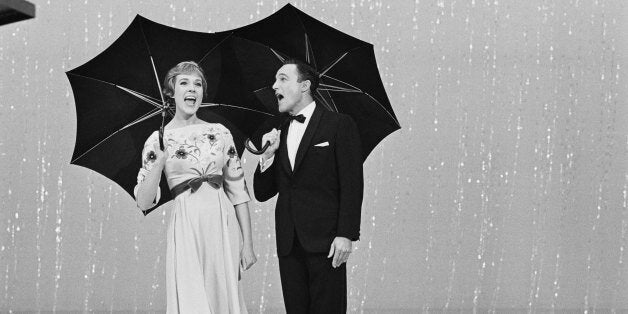
The outpouring of responses I received for my piece about Gene and the upcoming stage production of An American in Paris prompted me to think about creativity and influences and the question -- from whence comes art? Early in our conversations, Gene answered the question for me. "I believe that everyone has been influenced by people before him -- or events or happenings," he said. "The best just don't simply spring full-blown from the earth. They're picking up a seed that has been planted before."
For Gene, the seeds were many. "I stole from everybody," he said. Sometimes the borrowing was very conscious, as it was when he and his younger brother Fred went to Loew's Penn Theater in downtown Pittsburgh and picked up the steps of the great Bill Robinson. In Gene's mind, Robinson was "the epitome and the quintessence of tap dancing perfection." As he said, "There were guys that did more exciting stuff, like Buck and Bubbles, in rhythm styles. But Bill Robinson was it. I was very fortunate to be a young man coming along learning dancing when he was around." When I asked what was distinct about Robinson's style, Gene explained, "Nobody could get the ease and the grace and the sound that Bill Robinson got. I've never heard it quite that clean and clear again."
When I asked if he could he identify something in his films directly connected with Robinson, he said, "Sure, there are variations of Bill Robinson in the dance I do with Donald O'Connor in Singin' in the Rain -- 'Moses Supposes.' Variations of it, but, basically, some of those steps are from Bill Robinson." According to Gene, "Bill himself had lifted from older minstrel men and vaudeville people before him; things such as asides to the audience or making jokes during the dance." And then there was Robinson's famous canting of his hat that would become one of Gene's signature gestures. "He always wore a derby and he would take that off and fan himself or twist it. And when he'd make an exit, sometimes he would cock it over his eyes. We all stole that from Bill Robinson, and, Lord knows, he might have stolen it from an older minstrel man before my day, before I was even born."
The influences spread through all forms of dance. "I soaked up everything that everybody had to teach," he said, "I went to every dance performance that played in Pittsburgh, New York, Chicago, wherever I was. I would look at it. I'd imbibe it and it would be part of me." And, earlier, "I stole from Martha Graham and the American Ballet Theatre and all its great dancers. But I didn't think of it as that. I thought it was educating myself and knowing everything about dance I could know. I wanted to have enough dance that I could dance like Peer Gynt or I could dance like an American sailor getting off a ship."
It didn't stop there. Gene also turned to painting, sculpture, athletics, musicals, movies, books. "The more a dancer learns," he insisted, "the better he will be."
When I mentioned Gene's voracious appetite to dance historian Elizabeth Kaye, she said it reminded her of her friend Rudolf Nureyev. "He was like a huge Hoover, scooping up everything." When she asked him about his consumption, he replied with an impish grin, "I only steal from the best."
Though Gene appreciated when people paid tribute to his work, he never relished literal renderings. He preferred, instead, to see artists take his steps and ideas and turn them into something new. Referring to the role of the artist, he said, "If he just follows the leader and accepts what's been done before, naturally, that can be brought to a very high skill. But if he wants to change it in some way and do it differently, then it jumps up to the major league."
To Gene, Michael Jackson was one who made this leap. His movements were derivative, yet he transformed the many borrowings into a new and exciting art form. Like Gene, Michael had an uncanny ability to imitate things precisely. One night when Michael invited us to his house for dinner to discuss the possibility of him starring in a musical version of Frankie and Johnny, he stood in the living room and performed an exact rendition of Gene's "Ballin' the Jack" -- not the vaudeville-style number with Judy Garland in For Me and My Gal but the sexy, earthy version from Gene's hard-to-find 1959 Pontiac television special. He had it down to the minutest detail, including the Bill Robinson-inspired cocked hat. Later, when we were seated at the dining table, he launched into a near-perfect copy of "Makin' Whoopee," saying he loved Gene's harmonizing with Donald O'Connor on the old Eddie Cantor song.
I was struck by how much Gene and Michael were alike. Both were sponges, taking what they needed, modifying it, and setting aside the rest. By watching everything Gene did and mimicking his moves, Michael absorbed a whole history of dance -- a range of influences from the simple, clog-shoe-steps of Bill Robinson, to the masculine ballet of Russian Adolph Bolm and the modern ingenuity of Martha Graham -- and so much more.
Gene appreciated that Michael had "respect for the older generation," and that he made "no secret" of those who had helped to shape his style. For Gene, dance was a matter of influences and all dancers "have generations behind them." As he had advised his friend Fred Astaire years before when someone had stolen one of Fred's routines: "You mustn't get angry at this. You should be flattered that the guy stole your number. That's the sincerest form of flattery. That's happening to me, and I'm not going to resent it. I'm going to be proud of it."
Stealing from the best, indeed.